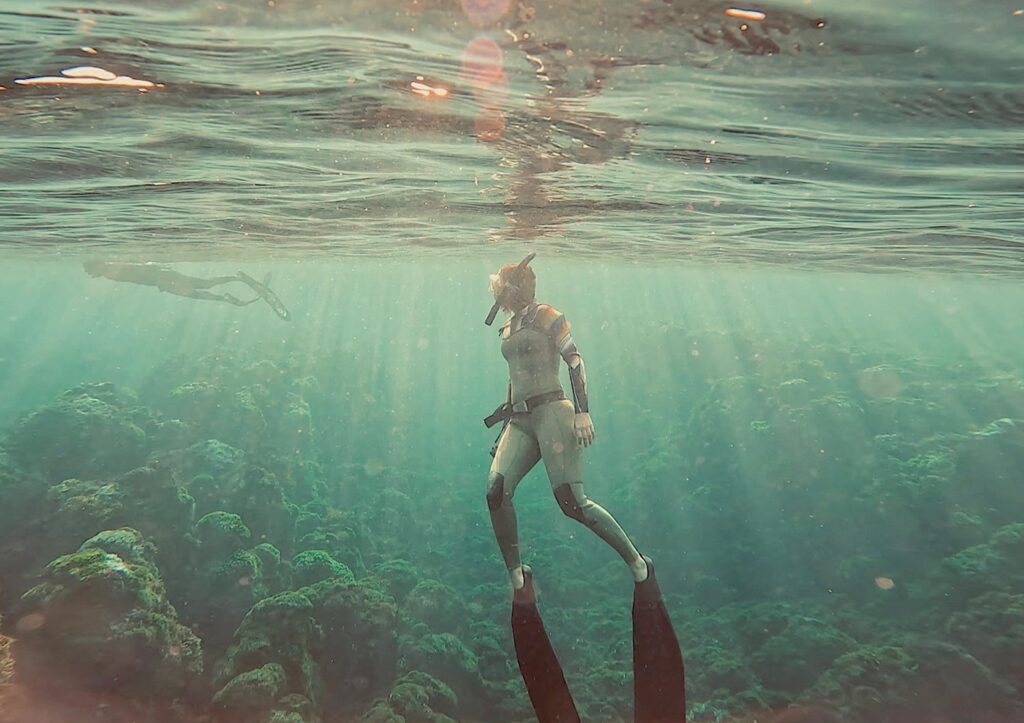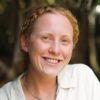A Freediver Finds Belonging Without Breath

Face down in deep water, I float. I inhale through a snorkel. My eyes are closed. Body relaxed. I raise one finger, motioning to my dive buddy that I am taking my last breath. Finally, after several minutes of floating meditation, I am ready.
I exhale all the air I possibly can.
My chest deflates. An uncomfortable tightness grips.
Grips me.
I take a single breath.
It is deep and full.
My chest expands. My stomach too.
I feel it in my throat.
With a splash, I duck-dive, pushing my hips in the air and my head down. I grab the line—a rope that is suspended from a buoy and anchored with weights that drop to the dive depth.
I pull myself deeper.
As I dive, a wetsuit clings to my body, forming a second skin that allows me to stay in the water longer without getting cold. Long fins morph my human legs into a mermaid-like tail. A mask fits tightly to my face, allowing me to see the line in front of me and the blue beyond. A rubber belt sits tightly on my hips. It is threaded with several kilograms of lead weights that help me sink, counteracting my body’s buoyancy.
Though I could freedive without any of this gear, it transforms me, allowing for immersion that seems to transcend being human.
I began freediving while living on Lord Howe Island, far off the east coast of Australia. This verdant, volcanic island—home to about 400 people—is my research field site where I am studying human-environment relations. Lord Howe and its Marine Park–protected waters are both listed as UNESCO World Heritage sites. Within these aquamarine waters lies the world’s southernmost coral reef. “This is our underwater playground,” says Liv Rose, my freediving teacher.
Before coming to Lord Howe, I had heard about freediving, but I thought it was a dangerous extreme sport I’d never try. That changed when I met Liv. I had always loved being in the ocean, and I took little convincing once I heard her talk about the unique feeling of freediving. Beyond that, I was anthropologically fascinated by why people might want to do something that seemed so counterintuitive: to hold their breath and fight all instincts to breathe in order to reach a new level of immersion.
Over the course of numerous classes, I absorbed the basics of freediving. Lying on the floor in Liv’s house, I learned to breathe again. To breathe as a freediver does—fully—and then to hold it until I couldn’t stand it any longer. With an oxygen monitor on my finger, I came to understand that though I felt I would black out any moment, I had “so much time,” as Liv would say in a calming voice.
I developed a new awareness of my body, discovering the parts of my anatomy I needed to control to equalize my ears. I researched people who have used the techniques of freediving for centuries. The Ama—Japanese fisherwomen divers. The Haenyeo—female divers of Jeju, South Korea, who harvest mollusks, seaweed, and other foods from the sea while holding their breath.
I learned about competitive freediving—the sport shown in the 2023 Netflix documentary The Deepest Breath and described in James Nestor’s book Deep. I wondered at the apparent obsession and addiction such freedivers have to get deeper, to push human boundaries.
My dive buddies and I don’t go to such extreme depths. Rather, we are using the techniques to explore. And what we have found, in a sense, goes even deeper: a new identity and a realization of what it means to be in reciprocity with the sea.
I am moving down slowly. At times I close my eyes to relax. There is no rush to the bottom.
Compared to scuba divers, who are laden with air tanks and take breaths that reverberate bubbles and noise, I move quietly, freely, gracefully. “It makes you feel like you are from the sea,” Liv says.
At around 10 meters deep, I reach a point where my buoyancy cancels out. I neither sink nor float. Below that, the water starts pulling me down. At these depths, freedivers can enter a free fall.
I descend deeper.
Each meter down, the water pressure increases. It makes my lungs shrink, my airways squeeze. With my free hand, I clamp my nostrils together and blow, equalizing the pressure in my ears.
I reach the bottom of the line.
I’m 20 meters deep.
I turn.
Tugging on the rope, I begin my ascent. This is just a taste of the addiction to depth. The freediving world record is 214 meters.
Without breath, carbon dioxide begins to build in my body.
My diaphragm tightens.
My ribs convulse.
These contractions come suddenly. They are my body’s way of telling me I should breathe. I am still meters away from the surface.
I’m running out of air.
I calm these thoughts. I know I can push past this human impulse. I’ve practiced on dry land, holding my breath for three minutes. In the mindful state of freediving, I don’t panic. I find stillness. Centeredness. Calm. I am belonging in the moment. I’ve retrained my mind to be underwater.
My body, meanwhile, is using the mammalian dive response to function. This is a set of physiological reactions that all mammals have, including humans. It’s triggered by being in water, especially when your face is submerged and you’re holding your breath. It slows your heart rate to increase your ability to preserve oxygen. (This is one reason it feels calming to splash water on your face.) Your body also shifts blood from your hands, feet, arms, and legs to your core, vital organs. This allows freedivers to stay longer in the state of apnea—meaning “without breath.”
As I near the surface, the urge to breathe builds. The contractions in my stomach become more severe. My dive buddy descends a few meters, meeting me on my return. She watches me for any signs that I might black out—which, underwater, can prove fatal.
We break the surface with a splash. I cling to the buoy. My dive buddy watches me intently. I could still black out. As Liv taught me, I take three exaggerated “recovery” breaths—fast inhales and long exhales. I make an “OK” signal to my buddy with my hand, saying the same. I’ve returned to the world above the surface.
One day, exploring underwater while freediving, Shawnee, one of the seasonal tourism workers, found an old car tire wedged in the coral reef. She decided that the rubber, which is toxic when it breaks down in the sea, didn’t belong. So she dragged it behind her on the swim back to the beach, then hauled it from the water for disposal.
Like many young people working seasonally in tourism on Lord Howe Island, Shawnee regularly bounces between places. I wondered, in my conversations with many of the seasonal workers, What might connect someone who moves so frequently to a sense of belonging?
“Underwater is where I feel truly accepted, at peace,” Shawnee said. “Maybe that is what home means to me.”
Freediving—like surfing, swimming, and other forms of immersion—gives you the feeling of transcending being human. It dissolves our sense of separateness from the ocean ecosystem. It brings a feeling of belonging. A sense of what I call a “citizenship of the sea.”
This relationship is transformative. It can translate to a desire to give back. Anthropologists call such exchanges of mutual benefit “reciprocity.”
Seeing Shawnee pull a tire from the reef and watching many others collect beach-washed plastic or rescue birds who had ingested it, I came to understand these acts as a form of reciprocity between people and the sea. These demonstrations of care simultaneously preserve environments and help ensure that people now and in the future may have the same experiences and opportunities to find happiness and belonging underwater.
Today amid a growing rift between humans and nature, it is important to understand how we belong in environments. How we—humans and other species, land, sea, and air—are all interconnected. By exploring new depths of immersion, enjoyment, and kinship in environments—through freediving, hiking, or other forms of being in nature—we can forge connections with the natural world and deeper relationships of care.
A sense of reciprocity with nature, above or below the sea, motivates us to give back more than we take. Through freediving, I’ve realized that when reciprocity flows from belonging, care is as necessary and natural as the desire to breathe.
Correction: July 10, 2024
A brief statement about scuba divers using “heavy oxygen” tanks was revised because only rarely do scuba divers use pure oxygen and only for specific purposes.







































